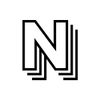New Research from the National Museum of Denmark Reveals Who Carved the Jelling Stone
After taking 3D scans, researchers can now reveal who carved the runes on the iconic Jelling Stone. The discovery shows that Queen Thyra was far more important than was previously assumed
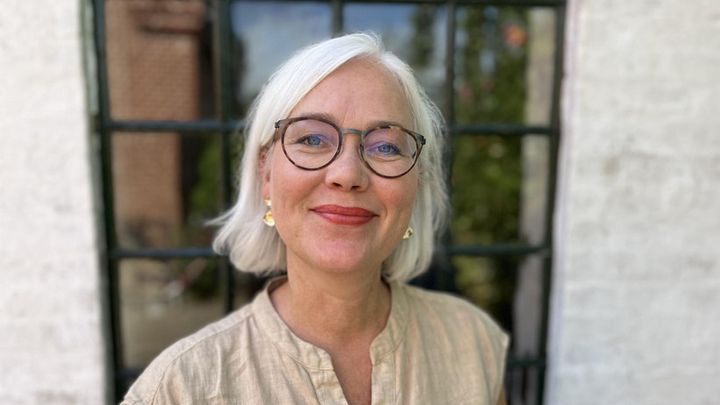
Researchers, including those from the National Museum of Denmark, can now disclose who carved the runes on the Jelling Stone. To an extent, just as handwriting is individual and can identify the owner of the writing, it turns out that, even though they were carved in stone, runes also reflect the runemaster.
3D scans of runestones enable researchers to gain a close-up view of traces of the carving process. This means they can tell the carving technique of the different rune stones apart. Every experienced stonemason holds his chisel at a certain angle and strikes the hammer with a specific force: this is visible in the angle of the traces of the carving and the distance between them. The motor function developed in such work is individual. Consequently, the researchers can now reveal the name of the runemaster who carved the Jelling Stone.
His name was Ravnunge-Tue: a Viking Age rune carver. Although few people will have heard of him, he is quite well-known in professional circles.
We know his name from the Læborg Stone situated 30 kilometres southwest of Jelling. The same carving technique that can be traced in the runes on the Jelling Stone are also evident on the Læborg Stone. The text on the Læborg stone reads: “Ravnunge-Tue carved these runes in memory of Thyra, his queen.”
Queen Thyra’s power revealed
Lisbeth Imer, a runologist and senior researcher at the National Museum of Denmark, explains that the discovery is interesting in itself, because it links yet another person to the Jelling dynasty. But what makes it particularly interesting is the fact that it also involves another interesting revelation.
Together with Laila Kitzler Åhfeldt of Riksantikvarieämbetet in Stockholm and Henrik Zedig of Länsstyrelsen in Västergötland, she conducted the research, the results of which will be published in October in the renowned academic journal Antiquity.
“The fact that we now know the name of the rune carver of the Jelling Stone is incredible; but what makes the discovery even more amazing is the fact that we know who Ravnunge-Tue’s boss was. She was Queen Thyra of Jelling – mother of Harald Bluetooth, wife of Gorm the Old,” says Lisbeth Imer.
The two Jelling stones mention Queen Thyra as the mother of Harald Bluetooth, wife of Gorm the Old and ‘Denmark’s salvation’. However, the name Thyra also appears on two other rune stones: the Læborg Stone, which Ravnunge-Tue carved in memory of Thyra; and Bække 1, which bears the inscription, ‘Ravnunge-Tue and Fundin and Gnyple, these three made Thyra’s mound.’
For many years, researchers have been debating whether the Queen Thyra of the Læborg Stone is the same as the Jelling Thyra.
However, based on the new research, the likelihood of two different Thyras is significantly less, because, according to the researchers who conducted the analyses, Ravnunge-Tue carved both the Læborg Stone and the Jelling Stone. Lisbeth Imer believes that this also highlights just how important Queen Thyra was.
Queen Thyra is mentioned on a total of four rune stones: more than any other person in Viking-Age Denmark. This is particularly noteworthy, since rune stones erected in honour of women are rare. By comparison, Harald Bluetooth and Gorm the Old are each mentioned on just two rune stones, and Gorm the Old is only mentioned in connection with Thyra.
“This means that Queen Thyra was far more important than we previously assumed. She probably came from a nobler, older family than Gorm the Old, whom we usually refer to as the first King of Denmark. This is extremely interesting when it comes to understanding the power structure and the genesis of Denmark as a nation,” says Lisbeth Imer.
All four rune stones that mention Thyra are located in Southern Jutland, implying that her power was based in this area, while Gorm the Old may have come from elsewhere.
“It is a wonderful insight. It relates to the ‘birth certificate’ of our country and the founding of early Denmark. Once again, our researchers have proved why we must continue to delve into the history of Denmark. That includes the part we already know, because we are constantly finding new answers that increase our knowledge of the past,” says Rane Willerslev, Director of the National Museum of Denmark.
The spectacular discovery forms the basis for a new Danish TV series – Gåden om Thyra (The Thyra Enigma) – which starts screening on DR TV today.
The researchers based their analyses on scans of seven runestones in Midwest Jutland: Bække 1 and 2, Læborg, Horne, Randbøl and older scans of the two Jelling stones.
The runes on the small Jelling stone are too worn for the researchers to identify the individual rune carver. They cannot confirm whether Ravnunge-Tue also carved this runestone.
The Jelling Stone
Featuring in every Danish passport, the Jelling Stone is known as the ‘birth certificate’ of Denmark, in which, 1,000 years ago, Harald Bluetooth boasted that he had united Denmark and Norway, and converted the Danes to Christianity. In 1994, the runestone was the main justification for Jelling’s inclusion on the UNESCO World Heritage List. It was the first site in Denmark to be granted that honour. The stone still stands on its original site. There are copies of the Jelling Stone all over the world: from Tokyo to Los Angeles.
CONTACT:
Troels Donnerborg
Journalist og redaktør /
Kommunikation / Communication
Telefon / Phone +45 41206340
Kontakter
Troels DonerborgJournalist og redaktør Nationalmuseet
Tlf:41206348troels.donnerborg@natmus.dkBilleder
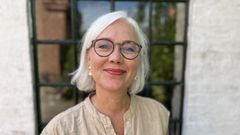
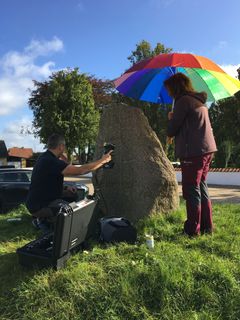
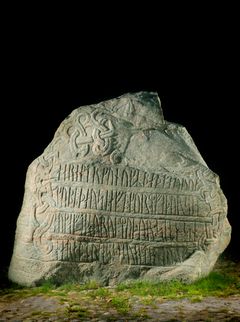
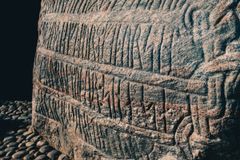
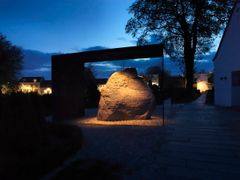
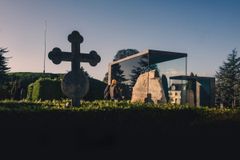
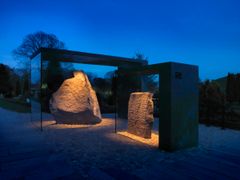
Links
Nationalmuseet
Nationalmuseet er Danmarks kulturhistoriske hovedmuseum. Det ligger i Prinsens Palæ i København, hvor det har haft adresse siden 1849.
Nationalmuseet består foruden af besøgsstedet i København også af en forsknings-, samlings og bevaringsafdeling, der tager sig af konservering og bevaring af Danmarks kulturskatte samt forskning i både kulturhistoriske og naturvidenskabelige emner.
Der er 18 besøgssteder knyttet til Nationalmuseets organisation, som Rane Willerslev er direktør for.
Følg pressemeddelelser fra Nationalmuseet – Forskning og Kulturarv
Skriv dig op her, og modtag pressemeddelelser på e-mail. Indtast din e-mail, klik på abonner, og følg instruktionerne i den udsendte e-mail.
Flere pressemeddelelser fra Nationalmuseet – Forskning og Kulturarv
Nyt studie: Klimaskabt tørke nedbryder fortidsminder på rekordtid27.11.2025 08:42:00 CET | Pressemeddelelse
Et nyligt publiceret studie viser, hvor hurtigt udtørring nedbryder arkæologiske fund i danske moser. Genstande af træ kan ligge bevaret i moser i flere tusinde af år, men når tørken rammer, kan de blive ødelagt på 2-3 måneder.
Ida Nicolaisen modtager Nationalmuseets jubilæumsmedalje29.9.2025 11:38:49 CEST | Pressemeddelelse
Efter en livslang indsats indenfor forskning modtager antropolog Ida Nicolaisen Nationalmuseets æresmedalje. Overrækkelsen fandt sted til Forskningens Aften.
H.M. Dronning Mary deltager i Forskningens Aften på Nationalmuseet11.9.2025 15:18:35 CEST | Pressemeddelelse
Når Nationalmuseet præsenterer sin nyeste og mest banebrydende forskning i et eksklusivt arrangement den 24. september, bliver det med deltagelse af H. M. Dronningen.
The National Museum discovers new details regarding Viking hairstyles27.8.2025 06:05:00 CEST | Press release
A small, unique gaming piece from the Viking Age reveals a hairstyle that was probably in vogue among Vikings at the time of Harald Bluetooth. This is as close as we get to a portrait of a Viking, says scholar.
Nationalmuseet opdager nye detaljer i vikingernes frisure27.8.2025 06:00:00 CEST | Pressemeddelelse
En lille, unik spillebrik fra vikingetiden afslører, hvilken frisure der formentlig var på mode blandt vikingerne på Harald Blåtands tid. Det tætteste vi kommer på et vikingeportræt, mener forsker.
I vores nyhedsrum kan du læse alle vores pressemeddelelser, tilgå materiale i form af billeder og dokumenter samt finde vores kontaktoplysninger.
Besøg vores nyhedsrum